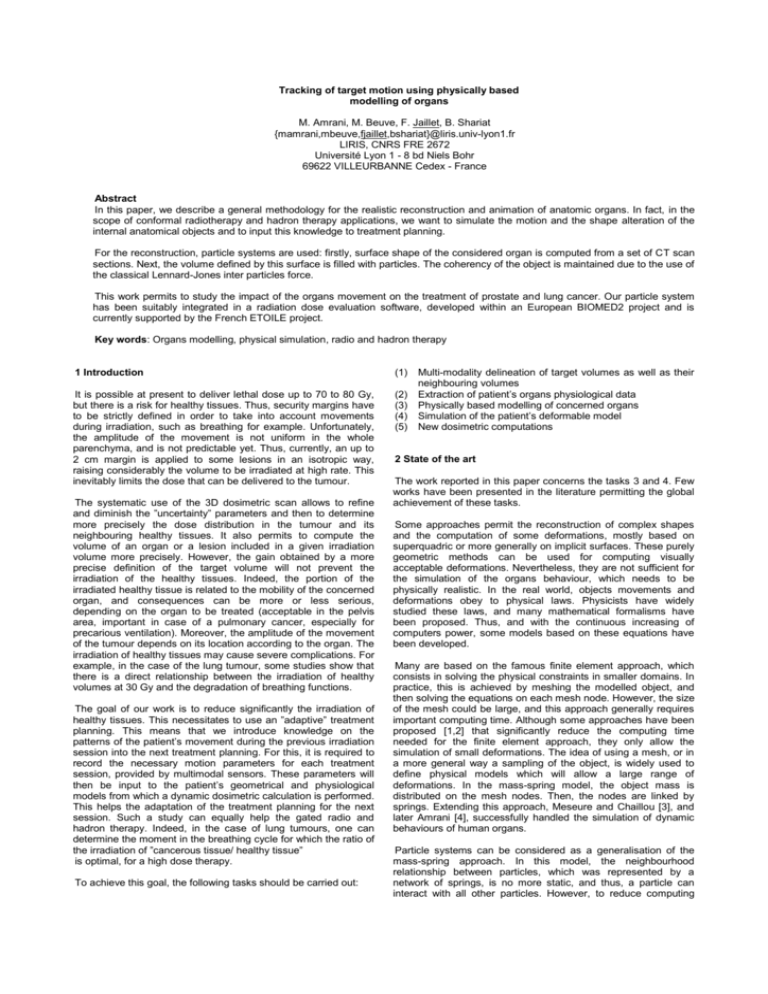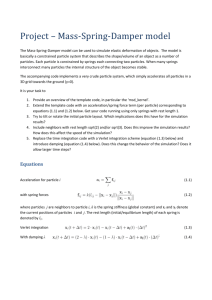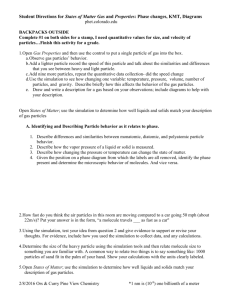Tracking of target motion using physically based modelling of
advertisement

Tracking of target motion using physically based
modelling of organs
M. Amrani, M. Beuve, F. Jaillet, B. Shariat
{mamrani,mbeuve,fjaillet,bshariat}@liris.univ-lyon1.fr
LIRIS, CNRS FRE 2672
Université Lyon 1 - 8 bd Niels Bohr
69622 VILLEURBANNE Cedex - France
Abstract
In this paper, we describe a general methodology for the realistic reconstruction and animation of anatomic organs. In fact, in the
scope of conformal radiotherapy and hadron therapy applications, we want to simulate the motion and the shape alteration of the
internal anatomical objects and to input this knowledge to treatment planning.
For the reconstruction, particle systems are used: firstly, surface shape of the considered organ is computed from a set of CT scan
sections. Next, the volume defined by this surface is filled with particles. The coherency of the object is maintained due to the use of
the classical Lennard-Jones inter particles force.
This work permits to study the impact of the organs movement on the treatment of prostate and lung cancer. Our particle system
has been suitably integrated in a radiation dose evaluation software, developed within an European BIOMED2 project and is
currently supported by the French ETOILE project.
Key words: Organs modelling, physical simulation, radio and hadron therapy
1 Introduction
(1)
It is possible at present to deliver lethal dose up to 70 to 80 Gy,
but there is a risk for healthy tissues. Thus, security margins have
to be strictly defined in order to take into account movements
during irradiation, such as breathing for example. Unfortunately,
the amplitude of the movement is not uniform in the whole
parenchyma, and is not predictable yet. Thus, currently, an up to
2 cm margin is applied to some lesions in an isotropic way,
raising considerably the volume to be irradiated at high rate. This
inevitably limits the dose that can be delivered to the tumour.
(2)
(3)
(4)
(5)
The systematic use of the 3D dosimetric scan allows to refine
and diminish the ”uncertainty” parameters and then to determine
more precisely the dose distribution in the tumour and its
neighbouring healthy tissues. It also permits to compute the
volume of an organ or a lesion included in a given irradiation
volume more precisely. However, the gain obtained by a more
precise definition of the target volume will not prevent the
irradiation of the healthy tissues. Indeed, the portion of the
irradiated healthy tissue is related to the mobility of the concerned
organ, and consequences can be more or less serious,
depending on the organ to be treated (acceptable in the pelvis
area, important in case of a pulmonary cancer, especially for
precarious ventilation). Moreover, the amplitude of the movement
of the tumour depends on its location according to the organ. The
irradiation of healthy tissues may cause severe complications. For
example, in the case of the lung tumour, some studies show that
there is a direct relationship between the irradiation of healthy
volumes at 30 Gy and the degradation of breathing functions.
The goal of our work is to reduce significantly the irradiation of
healthy tissues. This necessitates to use an ”adaptive” treatment
planning. This means that we introduce knowledge on the
patterns of the patient’s movement during the previous irradiation
session into the next treatment planning. For this, it is required to
record the necessary motion parameters for each treatment
session, provided by multimodal sensors. These parameters will
then be input to the patient’s geometrical and physiological
models from which a dynamic dosimetric calculation is performed.
This helps the adaptation of the treatment planning for the next
session. Such a study can equally help the gated radio and
hadron therapy. Indeed, in the case of lung tumours, one can
determine the moment in the breathing cycle for which the ratio of
the irradiation of ”cancerous tissue/ healthy tissue”
is optimal, for a high dose therapy.
To achieve this goal, the following tasks should be carried out:
Multi-modality delineation of target volumes as well as their
neighbouring volumes
Extraction of patient’s organs physiological data
Physically based modelling of concerned organs
Simulation of the patient’s deformable model
New dosimetric computations
2 State of the art
The work reported in this paper concerns the tasks 3 and 4. Few
works have been presented in the literature permitting the global
achievement of these tasks.
Some approaches permit the reconstruction of complex shapes
and the computation of some deformations, mostly based on
superquadric or more generally on implicit surfaces. These purely
geometric methods can be used for computing visually
acceptable deformations. Nevertheless, they are not sufficient for
the simulation of the organs behaviour, which needs to be
physically realistic. In the real world, objects movements and
deformations obey to physical laws. Physicists have widely
studied these laws, and many mathematical formalisms have
been proposed. Thus, and with the continuous increasing of
computers power, some models based on these equations have
been developed.
Many are based on the famous finite element approach, which
consists in solving the physical constraints in smaller domains. In
practice, this is achieved by meshing the modelled object, and
then solving the equations on each mesh node. However, the size
of the mesh could be large, and this approach generally requires
important computing time. Although some approaches have been
proposed [1,2] that significantly reduce the computing time
needed for the finite element approach, they only allow the
simulation of small deformations. The idea of using a mesh, or in
a more general way a sampling of the object, is widely used to
define physical models which will allow a large range of
deformations. In the mass-spring model, the object mass is
distributed on the mesh nodes. Then, the nodes are linked by
springs. Extending this approach, Meseure and Chaillou [3], and
later Amrani [4], successfully handled the simulation of dynamic
behaviours of human organs.
Particle systems can be considered as a generalisation of the
mass-spring approach. In this model, the neighbourhood
relationship between particles, which was represented by a
network of springs, is no more static, and thus, a particle can
interact with all other particles. However, to reduce computing
time, the number of neighbours has to be small, and this can be
achieved by reducing the action range of the interaction forces.
Miller et Pearce [5] proposed a general interaction law between
two particles, allowing them to simulate various behaviours from
liquid to deformable solid. In [6], Lombardo and Puech extend this
model to simulate muscles behaviours.
3.2 Object reconstruction
Our goal is to obtain a sampling of a volume defined by a closed
surface. This surface can be of any type and any topology. The
principle of our method presented in [8] is to fill the inner volume
with a set of particles. The reconstruction process can be divided
in several steps. The first one is the initialisation of particles inside
the boundaries. They will act as seeds to create new particles that
will progressively fill the whole object. Particles evolve until a
stable state which is a minimal energy configuration is reached.
Thus, we easily obtain a regular spatial sampling which
corresponds to a maximal filling. The algorithm 1 summarises our
reconstruction method.
3 Particle systems and deformable object modelling
3.1 Definitions
Particle systems consist of a set of solid spheres whose
movement follows physical laws. For deformable objects
modelling, this simple model has been improved by the
introduction of internal forces between particles to preserve the
cohesion of the object. Tonnesen [7] introduced a potential
energy function (Lennard-Jones potential) in computer graphics
applications. The corresponding forces have two terms: a short
range repulsion to prevent particles to overlap; a long range
attraction to ensure compactness and cohesion. Moreover, the
potential energies are conservative, the particle system may
oscillate. Thus damping forces are introduced to prevent system
instability. The interaction of a particle system with its
environment is represented by external forces (gravity, collisions,
etc.).
Algorithm 1
Initial particles creation
repeat for all particles
(1) collisions detection with the object boundaries
(2) internal and external forces computation
(3) computing velocities using physical law
(4) let particles evolve to a stable state
(5) create new particles around the existing ones
until object volume is filled up
Lennard-Jones potential is often used to model atoms
interactions. Generally, this potential is given by the following
equation:
A
B
r n m
r
r
If we want to increase the precision of the resulting model, we
need to decrease the radius of the particles thus dramatically
increasing the number of particles. To solve this problem, we
have developed a multi-layer model. The key idea is to place
small particles where details are required and big ones
elsewhere:
(1)
where A and B are constants. If the equilibrium distance is set to
r0
and the potential value at
r0
to
r0 , we can rewrite
Lennard-Jones formula as
m
r0 n
r 0
(r )
m n
m n r
r
(2)
which is the same as the previous one when taking
A
mr0n
mn
and , B
nr0m
mn
the centre is composed of particles of large radius. They act
as the core of the object.
the centre is surrounded by one or more layers with
decreasing radius as we get closer to the boundaries.
The coherency of each layer is preserved by virtual separations
between layers. Then, the reconstruction process can be
repeated for each layer [8], as shown on figure 2.
.
The derivative force from this potential is:
f r grad r
(3)
In eq. 2, it is clear that n controls the repulsive part of the
potential ( r
r0 ),
when m deals with the other part. Thus, the
deformability of the modelled object can be controlled (Fig. 1).
Fig. 1. Lennard-Jones potential and force
Fig. 2. Prostate reconstruction with a multi layers particle system
2
3.3 Animation and deformation of particle systems
The particles are subject to external and internal physical forces
that induce their movement. Thus, these forces will determine the
particles displacement, and, by extension, the shape alteration of
the modelled object.
One of the important points that should be handled to obtain a
more realistic behaviour is the control of the volume during the
deformation. Since the particle system is a sampling of the initial
object, it gives an immediate approximation of the volume. And
thus, the volume is naturally preserved. In some other
applications, we may be asked to change the volume. This is the
case for example during simulation of some organs like lungs
during breathing, or bladder. For a particle, if we change the
radius from R to R’, its volume is modified consequently, and
therefore the volume of the whole object changes. Of course, the
same approach can be extended for either decreasing or
increasing the volume.
Fig. 4. Bladder, prostate, rectum interactions simulation as
bladder volume increases.
4.2 Lungs simulation
4 Medical application
Our model has also been used to simulate the deformable
behaviour of the lungs during the breathing process. On figure 5,
the lungs which are surrounded by the thorax, interact with the
heart, the mediastinum, the spinal cord and the diaphragm.
During breathing, the lungs are also constrained by the ribs, and
other bones such as the scapula. These constraints have been
integrated into our model by imposing the back and upper parts of
the body shape to remain static. Figure 6 shows a simulation of
the breathing process.
The developed tools have been used within the framework of
cancer treatment by conformational radiotherapy in a close
collaboration with medical partners from the Christie hospital of
Manchester (UK) and the medical department of the university of
Magdeburg (D). We used our model to produce simulations of two
types of organs: the bladder-prostate-rectum and the lungs. The
following sections show some examples of our results. Ongoing
work is held within the ETOILE1 project.
4.1 Bladder-prostate-rectum simulation
As we can see on the modelling (Fig. 3), bladder, prostate and
rectum are in contact. Figure 4 shows three steps of the
simulation of the bladder, prostate, rectum interactions. In this
simulation, the volume of the top bladder increases by a factor of
3 during its filling. The prostate is consequently pushed down
onto the rectum whose movements are also constrained by the
surrounding bones.
Fig. 5. Model of lungs, heart, spine, mediastinum and thorax
5 Conclusions
In this paper, we have presented a new modelling technique of
deformable organs based on a multi layer particle system. These
models are able to simulate different organs behaviours from
solid to fluid state. Moreover, the use of particle systems will
avoid the difficult problem calculating collision forces and contact
surfaces between objects. Within an ongoing project, the
proposed modelling technique is actually integrated in a global
treatment system for clinical validation.
Fig. 3. Bladder (yellow)-prostate(red)-rectum (brown) modelling
within the bony pelvis as viewed from caudal
1
Espace de Traitement
http://ETOILE.univ-lyon1.fr
Oncologique
par
Ions
Légers,
3
References
(a)
[1] M. Bro-Nielsen, S. Cotin, Real time volumetric deformable
models for surgery simulation using finite elements and
condensation, Computer Graphics Forum 15 (3) (1996) 57–66.
[2] G. Debunne, M. Desbrun, M. Cani, A. H. Barr, Dynamic realtime deformations using space and time adaptive sampling, in:
Computer Graphics Proceedings, 2001, proceedings of ACM
SIGGRAPH’01.
[3] P. Meseure, C. Chaillou, Deformable body simulation with
adaptive subdivision and cuttings, in: 5th Int. Conf. in Central
Europe on Comp. Graphics and Visualization WSCG’97, Plzen,
CZ, 1997, pp. 361–370.
[4] M. Amrani, F. Jaillet, M.Melkemi, B. Shariat, Simulation of
deformable organs with a hybrid approach, Revue Internationale
de CFAO et d’Informatique graphique 16 (2001) 213–242.
[5] G. Miller, A. Pearce, Globular dynamics: A connected particle
system for animating viscous fluids, Computers and Graphics 13
(3) (1989) 305–309.
[6] J. Lombardo, C. Puech, Oriented particles: A tool for shape
memory objects modeling, in: Graphics Interface’95, Quebec City
(CAN), 1995.
[7] D. Tonnesen, Spatially coupled particle systems, in: ACM
SIGGRAPH’92 Courses Notes: Particles system modeling,
animation and physically based techniques, 1992, pp.4.2–4.21.
[8] F. Jaillet, B. Shariat, D. Vandorpe, Deformable object
reconstruction with particle systems, Computers & Graphics 22
(2-3) (1998) 189–194.
(b)
(c)
Fig. 6. Breathing simulation showing lung deformation between
relaxation (a), inspiration (b) and expiration (c)
We are currently investigating obtaining individualised patient
data from different modalities. The lung compliance can be
defined as the measured lung volume variation rate according to
the pressure variation. It gives information on stiffness and
extensibility of the lung tissues. It is thus an essential parameter
to be integrated in our model. So, it is possible to measure local
elasticities with the help of imagery techniques. For this, four
series of CT-Scan are necessary. The scan acquired in
spontaneous ventilation corresponds to the present practice. The
three other scans acquired at blocked positions according to a
validated research protocol will permit to determine whether the
irradiation with contention is more adapted compared to the one
in spontaneous ventilation. This study can also permit to
determinate more precisely the correlation between lungs filling
and thorax deformation with other techniques like external
sensors (camera) and to use this information to estimate the
internal volume and pressure variation. The model can also be
coupled with on-line imagery modalities. This will permit to
provide warnings when the position of the targeted organ deviates
from the expected one.
4







